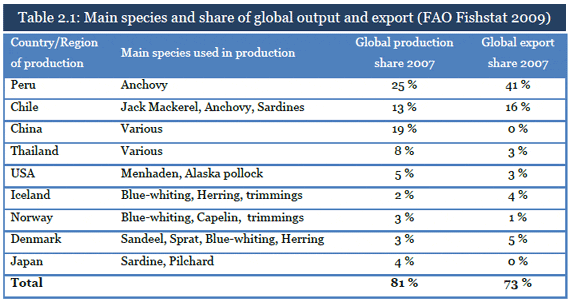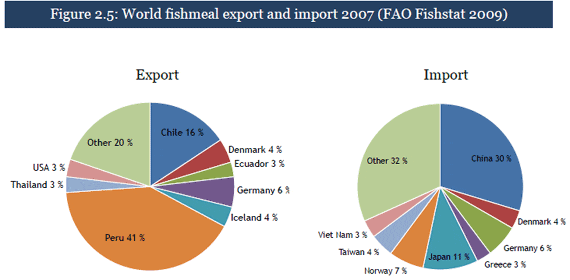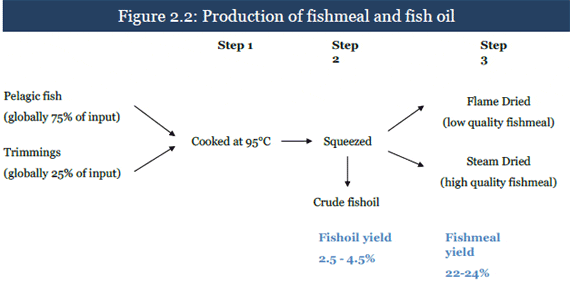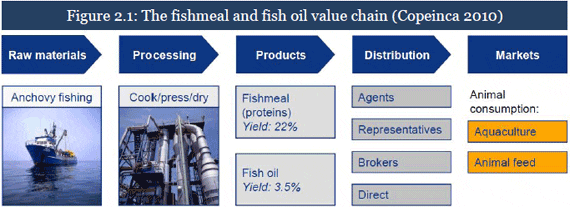How Fish Meal is Made
Posted by Spencer Doepel on
How Fish Meal is Made
Fishmeal has been around forever! At the beginning of the fourteenth century a primitive form of fish meal is mentioned in the Travels of Marco Polo "They accustom their cattle, cows, sheep, camels and horses to feed upon dried fish, which being regularly served to them, they eat without any sign of dislike."
The industrialization of fishmeal started as early as 800 AD when the utilization of herring as an industrial raw material took off in Norway. They had a very primitive process of pressing the oil out of herring by means of wooden boards and stones (Windsor). Nowadays fishmeal is used in feed production for many industry's and some industry rely on it heavily like the aquaculture industry.
The product fishmeal starts its life as one of a few different types of fattier fish called the Pelagic Fish. The Pelagic species are ocean fish that swim in schools and live in the upper sea levels. Their source of food is mainly plankton. The IFFO has estimated that in 2009 pelagic fish was used in 75% of all fishmeal production while the remaining 25% came from trimmings. The top producers of fish for fishmeal are Peru and Chile ("Explaining the production and consumption of fishmeal", 2012).


Storage
Before the fish are be taken to processing they have to be stored. All fisheries experience periods of abundance and scarcity. This leaves the fish meal factory at times with no raw material to process and at other times with too much. Large amounts of unprocessed material cause storage, odor problems and finally spoiled material becomes difficult to process and gives a lower yield. Refrigeration is not usually economic possible at this time and no cheap, completely safe method of preservation has yet been found (Windsor).
Processing
Once brought to processing they will undergo a three step process.
- First the fish will be inspected cleaned and cooked at about 95 Celsius to sterilize and separate out proteins and oils.
- Next the cooked fish is squeezed to free most of the remaining liquid.
- The material is then dried and is ready to be sold ("Explaining the production and consumption of fishmeal", 2012).

Drying
Although basically a simple operation, considerable skill is required to get the drying conditions just right. If the meal is under-dried, moulds or bacteria may be able to grow; if it is over-dried, scorching may occur and the nutritional value of the meal will be reduced.
There are two main types of dryers, direct and indirect.
In the direct dryer very hot air at a temperature of up to 500°C is passed over the material as it is tumbled rapidly in a cylindrical drum. This is the quicker method, but heat damage is much more likely if the process is not carefully controlled. The meal may not reach the temperature of the hot air, because rapid evaporation of water from the surface of each particle of fish causes cooling. Normally the product temperature remains at about 100°C.
The most usual type of indirect dryer consists either of a steam jacketed cylinder or a cylinder containing steam heated discs which also tumble the meal.
Fish meal is best kept in a cool dry place protected from rodents and birds. Spoilage is normally very slight even after excessively long periods of storage but fish meal will keep for several years without detectable change in its nutritional value.
Quality
Since fish meal contributes so many of the necessary ingredients of a diet, quality can be measured only on the basis of specific components. No single laboratory test has been or is likely to be devised that can give a total estimate of quality.
The Pepsin Digestibility test can distinguish between a very poor meal that has suffered heat damage and a good, properly processed meal, but these could probably be distinguished by color alone; the test is thus of limited practical use.
A total amino acid analysis gives useful information about the meal but is very expensive and tells nothing about the availability of individual acids to the animal being fed. Alternatively, the availability of a single important amino acid like lysine is often measured. This is probably the most useful approach, but nothing is then known about the other components. In short, there is no single comprehensive test for quality (Windsor).
Fishmeal quality can be grouped into four product market industry categories:
- High quality – used mainly for small-scale aquaculture units (eg trout farms).
- Low temperature meal – produced by steam drying, is highly digestible which nurtures rapid growth, and is thus especially suitable in salmon farming and piglet production.
- Prime – meal with a protein count between 66 and 68 per cent.
- Fair Average Quality (FAQ) – flame dried meal with a lower protein count (direct fire causes proteins to disintegrate).
Fishmeal typically contains 60-72% protein, 10-20% ash, 5-12% Fat and a High contents of fatty acids EPA and DHA or also know as long chain Omega-3s ("Explaining the production and consumption of fishmeal", 2012)
World Trade
Global production is concentrated around a few top producers who in 2007 made up 80% of the global production. There are approximately 300 dedicated plants worldwide that produce 6.3 million tons of fishmeal and 1.1 million tons of oil annually from roughly 33 million tons of whole fish and trimmings. For the last 20 years the global fishmeal output has remained at 6 to 7 million. While world trade averaged 3 to 4 million tons ("Explaining the production and consumption of fishmeal", 2012).

Explaining the production and consumption of fishmeal. (2012). Retrieved 27 June 2020, from https://thefishsite.com/articles/production-consumption-of-fishmeal
https://thefishsite.com/articles/production-consumption-of-fishmeal
Windsor, M. Fish Meal. Retrieved 27 June 2020, from http://www.fao.org/3/x5926e/x5926e01.htmhttp://www.fao.org/3/x5926e/x5926e01.htm
